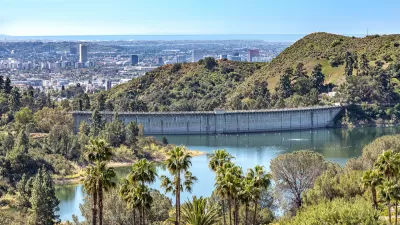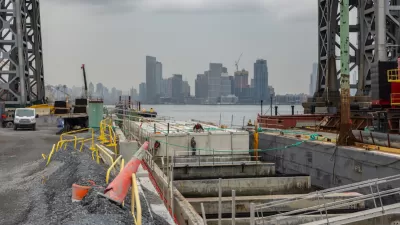How the city is taking action on green infrastructure and stormwater projects to protect neighborhoods from the rising risk of catastrophic flooding.

Linda Poon describes New York City’s efforts to plan for a more resilient future in the face of recurring floods. “[Hurricane Ida in 2021] and the ones before it, including a cloudburst downpour during Tropical Storm Elsa in July, have forced New York to take a hard look at becoming a ‘spongier’ city — one that combines nature-based green infrastructure like street-side rain gardens with gray infrastructure like storm drains to divert or absorb water and prevent catastrophic flooding.”
“A recent Arup report comparing the ‘sponginess’ of seven global cities ranked New York in the middle of the pack, after Auckland and Nairobi, and tied with Mumbai and Singapore. The researchers combined satellite imagery showing land use in the 58 square miles of each city’s main urban center with data from a global soil permeability analysis, and applied machine learning to determine their ability to manage sudden soakings.” According to the report, “Some 39% of the city is considered green spaces, leaving a bit less than two-thirds of the urban environment covered in impermeable surfaces.”
The article describes the challenges faced by the city in flood-proofing many of its neighborhoods and the limited potential for overhauling the city’s massive system of stormwater infrastructure. “In the more immediate term, the city is moving ahead with green infrastructure projects that can mitigate the most destructive kinds of flooding and help the city live with water from intense downpours.” Poon writes, “New York’s green infrastructure program was first laid out in 2010, and the city has since poured $1 billion into it. It’s become one of the nation’s largest, with more than 11,000 projects across all five boroughs that are either completed or under construction.”
FULL STORY: How New York City Plans to Soak Up the Rain

Alabama: Trump Terminates Settlements for Black Communities Harmed By Raw Sewage
Trump deemed the landmark civil rights agreement “illegal DEI and environmental justice policy.”

Study: Maui’s Plan to Convert Vacation Rentals to Long-Term Housing Could Cause Nearly $1 Billion Economic Loss
The plan would reduce visitor accommodation by 25% resulting in 1,900 jobs lost.

Planetizen Federal Action Tracker
A weekly monitor of how Trump’s orders and actions are impacting planners and planning in America.

Waymo Gets Permission to Map SF’s Market Street
If allowed to operate on the traffic-restricted street, Waymo’s autonomous taxis would have a leg up over ride-hailing competitors — and counter the city’s efforts to grow bike and pedestrian on the thoroughfare.

Parklet Symposium Highlights the Success of Shared Spaces
Parklets got a boost during the Covid-19 pandemic, when the concept was translated to outdoor dining programs that offered restaurants a lifeline during the shutdown.

Federal Homelessness Agency Places Entire Staff on Leave
The U.S. Interagency Council on Homelessness is the only federal agency dedicated to preventing and ending homelessness.
Urban Design for Planners 1: Software Tools
This six-course series explores essential urban design concepts using open source software and equips planners with the tools they need to participate fully in the urban design process.
Planning for Universal Design
Learn the tools for implementing Universal Design in planning regulations.
Caltrans
Smith Gee Studio
Institute for Housing and Urban Development Studies (IHS)
City of Grandview
Harvard GSD Executive Education
Toledo-Lucas County Plan Commissions
Salt Lake City
NYU Wagner Graduate School of Public Service





























